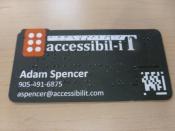In the world today there are approximately 42 million blind people. About 4 million of them live in the USA, and of those 4 million, about 1.5 million have access to a computer. What's the point of using a computer if you can not even see the screen? You will find out how this is accomplished using today's technology.
The best way for the blind to interpret text (other then speech) is Braille. Braille was developed by (and is named for) Louise Braille, a teenaged blind student at the worlds first school for the blind in Paris, France, in the 1820's. Braille was widely used up until around the 1960's when Braille's very simplicity and flexibility came to seem somehow old fashioned to some people. By the 1990's, it became clear that Braille's constituency was expanding in part because of computers.
Just like language translators, regular text has to be translated off the screen into Braille language.
One Braille character is about twice the size of one normal text characters, which makes it harder to save paper and longer to print (especially when the printer has to make perfect indents in the paper.) Since a Braille character is twice the size of a regular text, does Braille use twice as much paper? As with sign language, Braille has tons of shortcuts, that is one Braille character might stand for a word (in text) 3 or 4 letters long. So over all, about one sheet of regular text is equivalent to one sheet and a quarter sheet on Braille. Today's technology allows printers to print on both sides of paper in text. Is it possible for Braille to be double sided on paper? It is possible for Braille to be on both sides of a piece...


